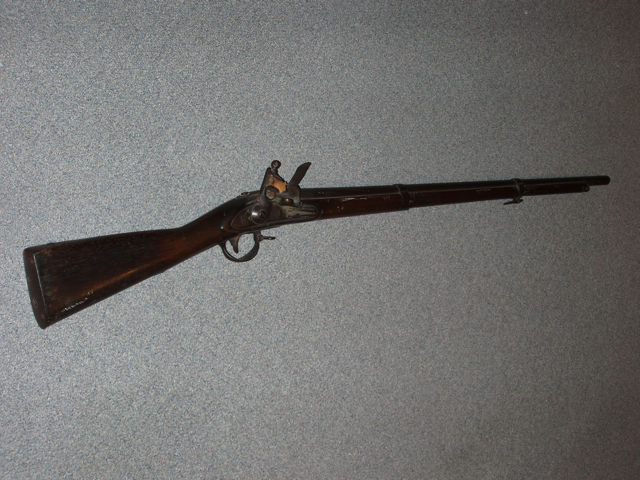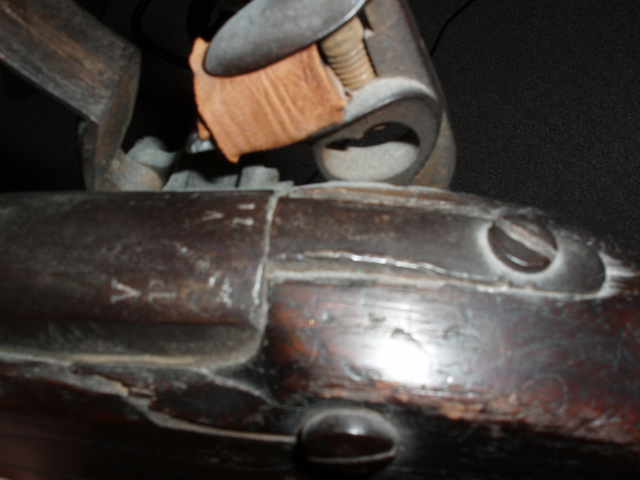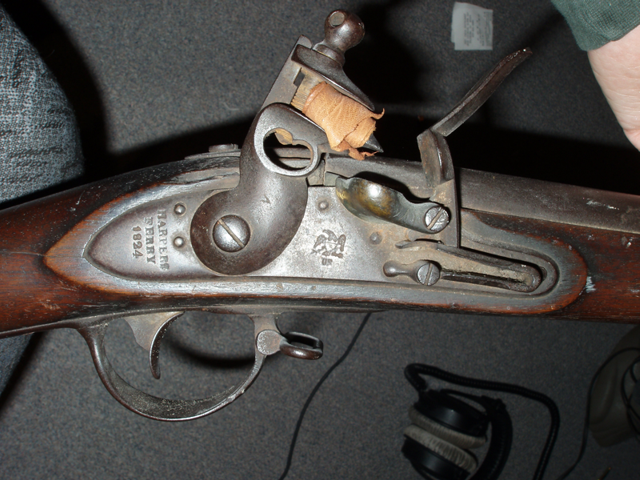farrieje
32 Cal.
- Joined
- Jan 16, 2007
- Messages
- 7
- Reaction score
- 0
I have a gun that was passed down to me. It is an 1824 Harper's Ferry Flintlock. Firstly, let me say that I don't know much at all about these guns. I was hoping that I might be able to tap this forum for some information about what, exactly, it is that I have. (I have already done some google searching and I haven't been able to turn up much of anything specifically about this firearm.) Folks ask me about the gun from time to time, but I really don't know anything more about it than what any layman could surmise from its markings. Any additional information folks could provide would be great. (Please excuse my ignorance on the names of parts, and please let me know what I SHOULD be calling things!)
As I said, the gun is marked as an 1824 Harper's Ferry. It is a smoothbore.

You may notice that it is missing the last clip that holds the barrel onto the stock. It appears as though the wood was broken a very long time ago, but I was wondering what the original length of the gun was as to determine if it was intentionally shortened. Would someone have intentionally shortened the barrel? Perhaps to make it lighter?
On the top of the gun, you can clearly see a large "VP" stamped into the side of the barrel, and a "V" with a "71" stamped in the center of the barrel. What can not be seen from the picture below, is a very faint "1824" etched into the the piece of metal on the right side of the image. What do the "VP" and the "V71" signify?

All of the metal hardware on this gun is stamped with the number "8". Every screw, bolt, whatever...they are all stamped with "8". What does the "8" mean?

Finally, here is a picture of the actual flintlock mechanism. I just wanted to include this in the event it told someone something else about the gun.

Aside from any historical information, how should I help to preserve and care for the gun? I know it's not museum-quality show-piece, but it is my little piece of history. I want to make sure I take care of it.
The gun is missing its ram-rod. Would it be possible to get an original to keep with the gun for display or is there a source of reproduction ones I should check out?
Any and all help is greatly appreciated!
- Farrier
As I said, the gun is marked as an 1824 Harper's Ferry. It is a smoothbore.

You may notice that it is missing the last clip that holds the barrel onto the stock. It appears as though the wood was broken a very long time ago, but I was wondering what the original length of the gun was as to determine if it was intentionally shortened. Would someone have intentionally shortened the barrel? Perhaps to make it lighter?
On the top of the gun, you can clearly see a large "VP" stamped into the side of the barrel, and a "V" with a "71" stamped in the center of the barrel. What can not be seen from the picture below, is a very faint "1824" etched into the the piece of metal on the right side of the image. What do the "VP" and the "V71" signify?

All of the metal hardware on this gun is stamped with the number "8". Every screw, bolt, whatever...they are all stamped with "8". What does the "8" mean?

Finally, here is a picture of the actual flintlock mechanism. I just wanted to include this in the event it told someone something else about the gun.

Aside from any historical information, how should I help to preserve and care for the gun? I know it's not museum-quality show-piece, but it is my little piece of history. I want to make sure I take care of it.
The gun is missing its ram-rod. Would it be possible to get an original to keep with the gun for display or is there a source of reproduction ones I should check out?
Any and all help is greatly appreciated!
- Farrier




